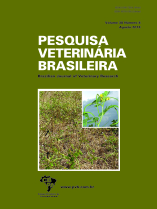 |
|
|
|
Year 2018 - Volume 38, Number 8
|

|
Poisoning of cattle by Senecio spp. in Brazil: a review, 38(8):1459-1470
|
ABSTRACT.- Panziera W., Pavarini S.P., Sonne L., Barros C.S.L. & Driemeier D. 2018. Poisoning of cattle by Senecio spp. in Brazil: a review. [Intoxicação por Senecio spp. em bovinos no Brasil: revisão de literatura.] Pesquisa Veterinária Brasileira 38(8):1459-1470. Setor de Patologia Veterinária, Faculdade de Veterinária, Universidade Federal do Rio Grande do Sul, Av. Bento Gonçalves 9090, Prédio 42505, Porto Alegre, RS 91540-000, Brazil. E-mail: davetpat@ufrgs.br
Poisoning of cattle by plants of the Senecio genus represents an important cause of death in cattle and has important economic repercussions in southern Brazil. This review is intended to provide a detailed review of Senecio spp. intoxication in cattle and addresses issues regarding the toxic principle and pathogenesis of the disease caused by these plants and the epidemiology, clinical signs, diagnosis, control and prophylaxis of the disease. Senecio brasiliensis is the main species associated with natural intoxication of livestock in Brazil, and the number of cases associated with the ingestion of S. madagascariensis is increasing. The toxic principle of Senecio spp. comprises the hepatotoxic alkaloids of the pyrrolizidine group (pyrrolizidine alkaloids, PAs). The resulting liver lesions are chronic and irreversible and result from the inhibition of hepatocellular mitosis. Deaths of adult cattle may occur both sporadically and in larger outbreaks over an extended period of time. In cattle raising, Senecio spp. are consumed mainly during the winter, when there is a dearth of forage; at this time the poisonous Senecio species are budding and contain high concentrations of PAs. Spontaneous Senecio spp. intoxication in cattle is a chronic condition that frequently involves acute clinical manifestations. Affected cattle may present ascites, emaciation, intermittent dark diarrhea, tenesmus, rectal prolapse, and neurological signs resulting from hepatic encephalopathy. Hepatogenous photosensitization may be observed but is uncommon. Necropsy findings include dependent subcutaneous edema, ascites, and edema of the mesentery, abomasal folds, and gallbladder. The liver is firm, normal or reduced in size with a white, thick capsule. Microscopically, the hallmarks of Senecio-associated disease are varying degrees of hepatocellular megalocytosis, bile duct hyperplasia and fibrosis. Sheep are significantly more resistant to Senecio intoxication than are cattle and avidly ingest Senecio plants; therefore, the use of sheep for grazing infested pasture is recommended for preventing the associated disease in cattle. |
| |
|
|
| |
|
 |